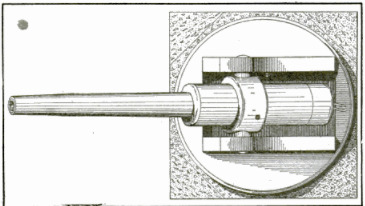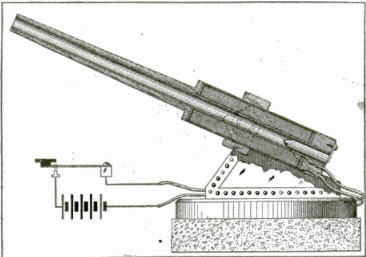This Toy Gun's Projectile Is Driven by Electricity
Contenuto
-
Titolo
-
This Toy Gun's Projectile Is Driven by Electricity
-
Article Title and/or Image Caption
-
This Toy Gun's Projectile Is Driven by Electricity
-
extracted text
-
A TOY gun, which is made of 1/8-in. brass pipe, makes use of the movement of an iron armature into the magnetic field of a solenoid when the current is applied. Mounted near the rear end of the pipe is a coil winding of the usual type. The proportions shown have been found effective. The gun can be made in any size desired so long as the proportions are kept. In order to give the appearance of a long-distance rifle, a wood sleeve is turned and pushed over the front end of the pipe and a wood part turned and pushed over the rear part.
The coil is wound on the space thus made; but first an iron or steel washer is pushed over the pipe at each end of the coil space in order to strengthen the flux. The winding is arranged in even layers and shellacked after each layer is completed; or, better still, enameled wire may be used which will give more wire and consequently more strength to the coil. When the winding is finished a piece of thin steel tubing is pushed over it, which bridges between the two washers, thus completing the magnetic circuit. If steel tubing, which is the best material, cannot be procured, a piece of thin tin may be wrapped around and soldered to form a tube, or else part of a tooth-powder box may be used. This iron casing is very important, as the strength of the gun will be greatly increased by its use. This tube is also used to support the gun. As the illustration shows, two brass hubs are turned and soldered to the steel tube and mounted in a wood carriage. In this way the elevation of the gun, which determines the range, may be controlled.
The projectiles consist of pieces of soft iron rods which are inserted at the rear and held in place by the hanging piece shown. The gun is fired by depressing the key which connects the battery, and releasing it again quickly. It is, of course, evident that the projectile tends to move to the center of the solenoid, and if the key is not released at the proper time, the projectile will either be drawn back into the gun or retarded in its flight. This fact introduces an element of skill into the firing of the gun.
Reaching the greatest range is, in all probability, the reason for the great fascination the gun has had for old folks as well as young. —CHARLES HORTON
-
Autore secondario
-
Charles Horton (writer)
-
Lingua
-
eng
-
Data di rilascio
-
1919-02
-
pagine
-
94
-
Diritti
-
Public Domain (Google digitized)
-
Archived by
-
Davide Donà
-
Marco Bortolami (editor)



